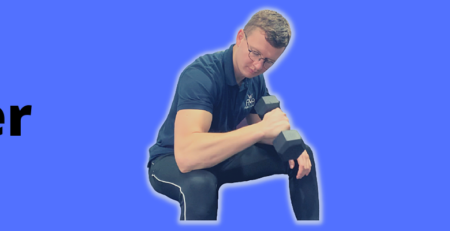Tennis elbow
Tennis elbow usually presents with pain right on the outside of the elbow. This is also known as lateral epicondyle pain. Generally, the issue occurs due to an overuse injury. For example, doing something you don’t normally do where you’ve overstressed the common wrist extensor origin. A good example would be a DIY project such as drilling.
The common extensor origin attaches to the elbow but is all based on the movement of the hand and fingers. You can try this, if you wiggle your fingers you’ll see the muscle moving at the elbow. So this can get set off with anything where there is resistance on the hand and you’re stopping the wrist from bending, so this can be just lifting something up, pouring a kettle, or anything where moving the wrist into extension. For example, brushing a dog or washing a car. Honestly, it’s not until you’ve got tennis elbow you realise how much you actually use those muscles in normal daily activities.
So let’s look at exercises on this area to help rehab it.
Exercise 1. Isometric wrist extension
This is the beginning exercise to start on and make sure you can tolerate this before moving on. Have your forearm resting on a surface and then it’s simply just holding a weight with the palm facing down so you activate that common extensor origin. You can progress or regress this by changing the weight you hold or the time you hold it for, you want to gradually build this up ensuring you aren’t making any symptoms worse during or following the exercise. If you overload with the exercises you can make symptoms worse as it’ll be the same irritation with activities you’re doing during the day.
Great exercise for the tennis elbow
Exercise 2. External rotation of the shoulder
Now this is an exercise for the rotator cuff, but strengthening the shoulder is important and you’ll rarely use the elbow without using the shoulder, so if your shoulder is weaker the elbow can end up taking more. Doing this external rotation will also give activation of the common extensor origin because you’ll be keeping the wrist neutral while you do it, so a great double-whammy exercise. Again adjust this by changing the weight and rep number.
Exercise 3. Eccentric wrist extension
Progressing things further you’ll now be adding movement at the wrist focusing on the eccentric portion of the movement. Grab the weight and lower slowly through the range. Use your other hand to help lift back up and repeat. Change the weight and number of reps to change the difficulty.
Exercise 4. Wrist extension
Now you’re going to be moving through the range doing the concentric and eccentric parts of the movement. This will be further down the line with rehab as things are starting to improve. Keep it slow and controlled lowering the weight the same as the eccentric one but this time lifting it up as well. Change the weight and reps again to adjust this.
Exercise 5. Supination/pronation
This is also one for when things are starting to improve where you’ll rotate the wrist from palm or pronation and move it towards palm up or supination, this movement will still get the extensors working well. Again adjust weight and reps accordingly.
Research
If we look at the research at what other things can help we have conflicting advice. Most would agree now that doing a steroid injection isn’t advised for the tennis elbow and can at times lead to worse pain. We have a study that says exercises are good with a focus on eccentric training which is exercise 3. It also says deep friction can be good but this is generally highly contested but still common in practice. Finally, the more recent review from 2021 says that exercises would be recommended. Contrary, an even more recent one from 2022 says exercises and other current treatments aren’t recommended.
In time it’ll likely get better by itself. And a lot of the time for tennis elbow it’s normal that this can linger and typically can last around a whole year for people. It does not mean that it’ll constantly be bad over that year. Most likely, it’ll keep getting set off and you’ll feel you can’t get rid of it, but in time even with no treatment it will eventually improve just work and trying not to aggravate it.
Things will continue to be contested, currently, though we would say giving exercises a go would make sense. This keeps the area strong so you’re less likely to lose capacity in the elbow and shoulder if using this less overall due to pain. When exercising you want to make sure that it isn’t irritating your painful site.
If you are struggling with elbow pain and need a consultation, you could find us in Nottingham. You could give us a call on 0115 901 7867 or use our online booking system.









